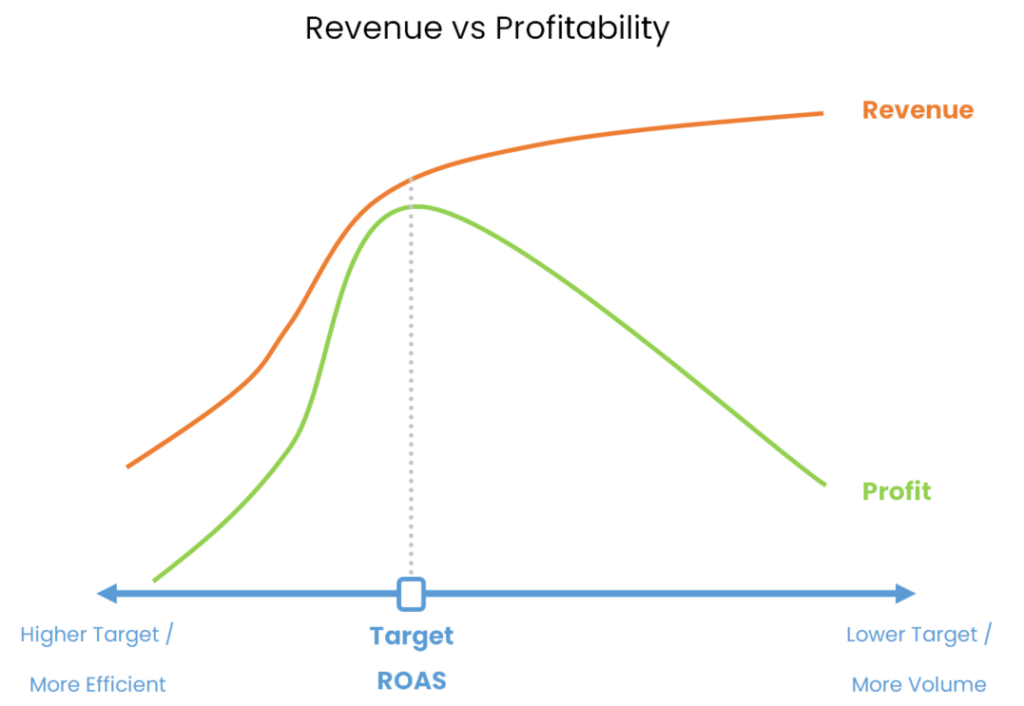Has Your PPC Revenue Hit a Plateau?
Are you finding that the recent climate of rapid change and financial uncertainty is pushing your PPC advertising into a plateau? If so, it’s critical to boost your PPC to the next level and to stay close to evolving consumer needs and behaviours.

If your PPC results have hit the “plateau”, look closely at the following:
- Increasing conversion rate
- Further reducing spend wastage
- Checking account structure and tracking
- Widening your product catalogue
- Considering a lower ROAS target
- Adjusting your pricing/profit targeting
Here we will address the benefits of each.
Increasing Conversion Rate #
It goes without saying, increasing conversion rate will boost your revenue for the same advertising spend.
The first port of call is your Google Ads account – can you gain conversions through higher targeted quality traffic? This is where the power of Google Ads’ Artificial Intelligence comes into play. [reference link to the power of AI & Automated Bidding Strategies]
Secondly, review your website landing pages. A landing page can make or break a lead or sale. Make sure your pages are fast loading on browsers and desktops. Show clear calls to action and make sure you differentiate your brand/products from the competitors. Social proof also goes a long way to boost conversions through increased trust so link your Google Ads reviews where you can. For more tips to improving landing page conversion rates.
Reducing Wasted Ad Spend #
What is the biggest block to performance that we find in the audits we undertake for new clients? Wasted ad spend. Money is often being thrown at campaigns, ad groups, keywords and extensions that just aren’t converting. It could be that you’re seeing great performance in certain areas and therefore assume that the overall account is doing well. However, we can almost guarantee that your average ROAS/revenue is being brought down by low performing assets. Remove that wasted ad spend and you will see a performance boost.
Improve Your PPC Targeting #
Drive more conversions with better targeting of your target market. A well structured PPC account can expand audience targeting with Performance Max, Broad Match and Dynamic Search Ads as well as across multiple channels and audience segments. Once consistency in volume is achieved, those methods can be refined by careful training of machine learning and Google Artificial Intelligence to expand reach into the gold standard of high quality traffic.
Adjusting Your Pricing/Profit Targeting #
Did you know that you can even set your website dataLayer to measure and target POAS instead of ROAS? Fine-tuning your campaigns to focus on profit rather than a flat revenue/ROAS means highly targeted campaigns maximising profit rather than revenue. Given that profit margins are likely different with each product, split your products into their appropriate margin groupings such as low, medium and high. This allows for better targeting to get more visibility and conversions focused on the specific products that bring you a greater return. It’s time to get clever with product targeting to maximise profit efficiency!
Considering a Lower ROAS Target #
If your current campaigns are targeting a certain ROAS figure, it may be time to re-adjust and set the target lower. A lot of people don’t realise that higher ROAS targets can reduce revenue. This is because the artificial intelligence that runs ROAS bidding will exclude your ads from showing for user profiles that are likely to convert, but at a lower ROAS. Let’s say for example, you have a target ROAS set at 800%. It could be that Google Ads is not bidding on user searches/profiles that would convert at 500% ROAS. This is effectively reducing the capacity of your account to bring in extra revenue.
Check Account Structure & Tracking #
If your campaign has structural problems or incorrect tracking installed, the Google Ads algorithms will be running from incorrect data and targets. This results in an account that may be performing ‘satisfactorily’ but will never be able to break through the plateau to the next level.
A useful analogy is to think of a house building process that starts from a solid foundation. If the foundation is rickety, the house will always crack, no matter how much plaster is applied! A firm foundation of account structure and tracking are key to optimising performance.
Widening Your Product Catalogue #
This is a great way to capture increased demand. Use search trends data to identify how trends are changing and map this to a widened portfolio of products.
For example, did you know that the latest search trends show that current concerns relating to inflation and increased searches for sustainable products are going hand-in-hand? As consumers look for ways to cut costs, many of the more affordable alternatives have longer term sustainability.
The UK is currently experiencing a boom in search phrases containing “second-hand” and “used”. In particular, searches for “second-hand washing machines” and “second-hand wedding dresses” have seen the highest increase in search volume. Internationally, search interest in Italy has grown for “incentivi auto elettriche” (electric car incentives), “subventions panneaux solaires” (solar panel subsidies) in France, and “subsidie warmtepomp” (subsidy heat pump) in the Netherlands.
Running parallel to this is also an increase in searches for smaller luxury items such as “luxury perfumes” and “luxury underwear”. This data shows that amid economic uncertainty people are trying to find the right balance between “cheap” and “luxury”. It’s critical to stay close to evolving consumer needs and behaviours.
Powered by BetterDocs
